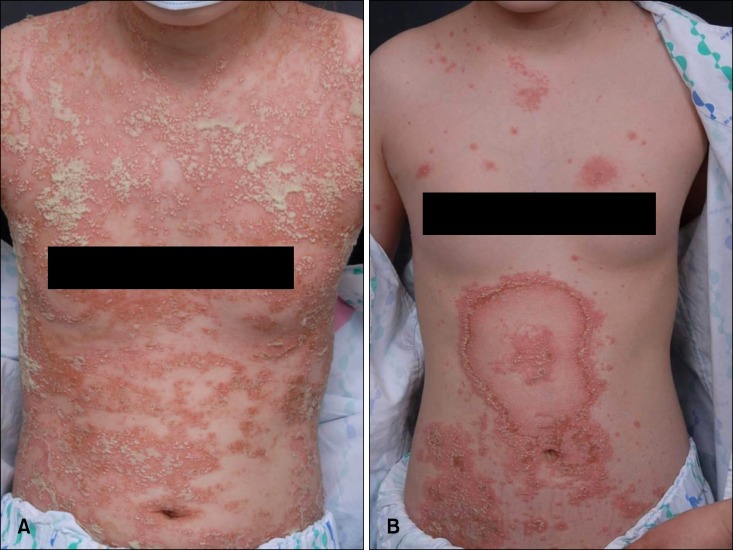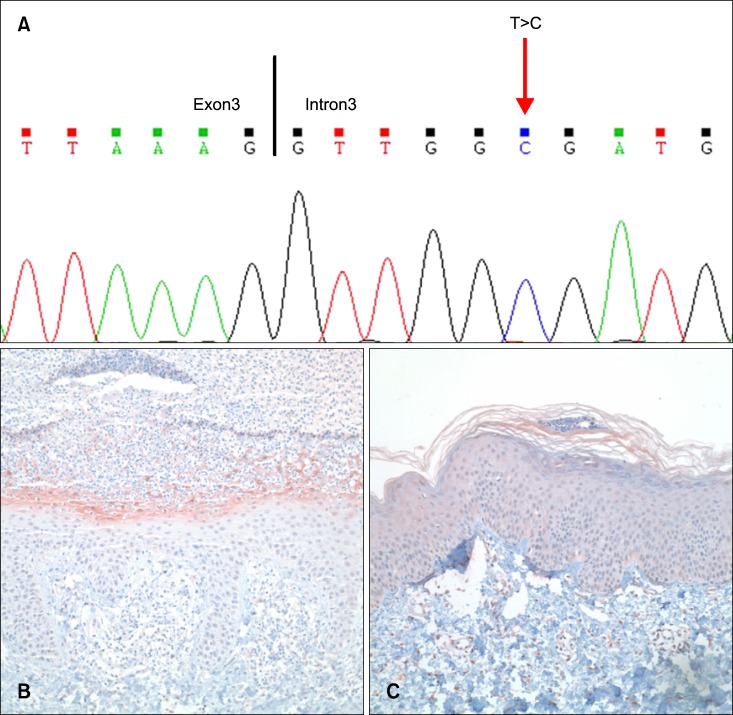Dear Editor:
Generalized pustular psoriasis (GPP) is a multisystemic inflammatory disorder showing extensive pustular eruptions over the entire body1. Recently genetic studies with GPP patients have shown mutations in interleukin-36 receptor antagonist (IL-36RN)2,3,4. A 17-year-old girl visited the emergency department with generalized pustules. Three days before visit, she complained of a febrile sensation followed by extensive pustular eruptions on whole body. Physical examination revealed pustular patches covering >90% of body surface area that formed a more aggressive pattern comparing with the previous attack (Fig. 1). Fever (39.1℃), leukocytosis (white blood cell count, 27,000/µl), increased erythrocyte sedimentation rate (59 mm/h), and increased C-reactive protein level (14.52 mg/dl) were noted. She was diagnosed with GPP at 4 years of age and had undergone regular follow-up. Flare-ups, large and small, had occurred along with extensive pustules. Whenever the patient suffered from acute flare-ups, systemic corticosteroids, methotrexate, cyclosporin, and even infliximab was used to effectively control symptoms. Recently, however, her symptoms had worsened with systemic symptoms such as high-grade fever, malaise, and myalgia. Skin lesions were also more extensive pustules. On the contrary, the empirical treatments were ineffective. In particular, the efficacy of infliximab, which was initially high, had gradually decreased, requiring additional medication. We considered this patient's condition recalcitrant and tried to determine a genetic problem. Genomic DNA extracted from her blood mononuclear cells was subjected to nucleotide sequencing and polymerase chain reaction using the primers as previously described4. The patient was heterozygous for a point mutation in intron 3 designated as c.115+6T>C, which led to the skipping of exon 3 at the transcript level and the production of a premature termination codon (Fig. 2A). This finding is partially compatible with that of a Japanese report in which a c.115+6T>C mutation was observed but differed in that no c.368C>G or c.28C>T mutation was noted in this case4. Furthermore, at the protein level, we observed overexpression of IL-36 on the keratinocytes below the pustular lesions using polyclonal anti-IL-36α/IL-1F6 antibody (diluted 1 : 200; R&D systems Inc., Minneapolis, MN, USA) (Fig. 2B, C). IL-36 activates inflammatory pathways such as the nuclear factor-κB pathway and are regulated by IL-36RN5. Several reports have performed mutation analyses of GPP patients showing that patients with IL36RN mutations are related to severe episodic GPP and these patients are affected at a relatively younger age2,3,4. In our case, onset of the disorder was early (age 4 years), and the patient's clinical course seemed to be worsening; therefore, we conducted gene mutation analysisto detect heterozygousity of point mutation in intron3. Compound heterozygosity or homozygous mutations have been reported in Europe and Japan4. On the other hand, in our case, only 1 point mutation in intron 3 was noted, and no mutations at the other 3 sites that were reported in earlier cases were found. We regard our patient as the first Korean GPP case in which the mutation was confirmed at the genetic and protein levels. We propose that physicians must consider gene mutation analysis for patients with early-onset and recalcitrant GPP.
Fig. 1.
More extensive and aggressive pustular patches (A) covering >90% of the body surface area compared to those observed in the previous attack (B).
Fig. 2.
Mutation c.115+6T>C observed in a Korean patient (A). At the protein level, a higher expression of interleukin-36 (IL-36) is noted on keratinocytes below the pustules (B) compared to those of psoriasis vulgaris (C) (B, C: polyclonal anti-IL-36α/IL-1F6 antibody, ×200)
References
- 1.Griffiths CE, Barker JN. Pathogenesis and clinical features of psoriasis. Lancet. 2007;370:263–271. doi: 10.1016/S0140-6736(07)61128-3. [DOI] [PubMed] [Google Scholar]
- 2.Marrakchi S, Guigue P, Renshaw BR, Puel A, Pei XY, Fraitag S, et al. Interleukin-36-receptor antagonist deficiency and generalized pustular psoriasis. N Engl J Med. 2011;365:620–628. doi: 10.1056/NEJMoa1013068. [DOI] [PubMed] [Google Scholar]
- 3.Onoufriadis A, Simpson MA, Pink AE, Di Meglio P, Smith CH, Pullabhatla V, et al. Mutations in IL36RN/IL1F5 are associated with the severe episodic inflammatory skin disease known as generalized pustular psoriasis. Am J Hum Genet. 2011;89:432–437. doi: 10.1016/j.ajhg.2011.07.022. [DOI] [PMC free article] [PubMed] [Google Scholar]
- 4.Farooq M, Nakai H, Fujimoto A, Fujikawa H, Matsuyama A, Kariya N, et al. Mutation analysis of the IL36RN gene in 14 Japanese patients with generalized pustular psoriasis. Hum Mutat. 2013;34:176–183. doi: 10.1002/humu.22203. [DOI] [PubMed] [Google Scholar]
- 5.Debets R, Timans JC, Homey B, Zurawski S, Sana TR, Lo S, et al. Two novel IL-1 family members, IL-1 delta and IL-1 epsilon, function as an antagonist and agonist of NF-kappa B activation through the orphan IL-1 receptor-related protein 2. J Immunol. 2001;167:1440–1446. doi: 10.4049/jimmunol.167.3.1440. [DOI] [PubMed] [Google Scholar]




